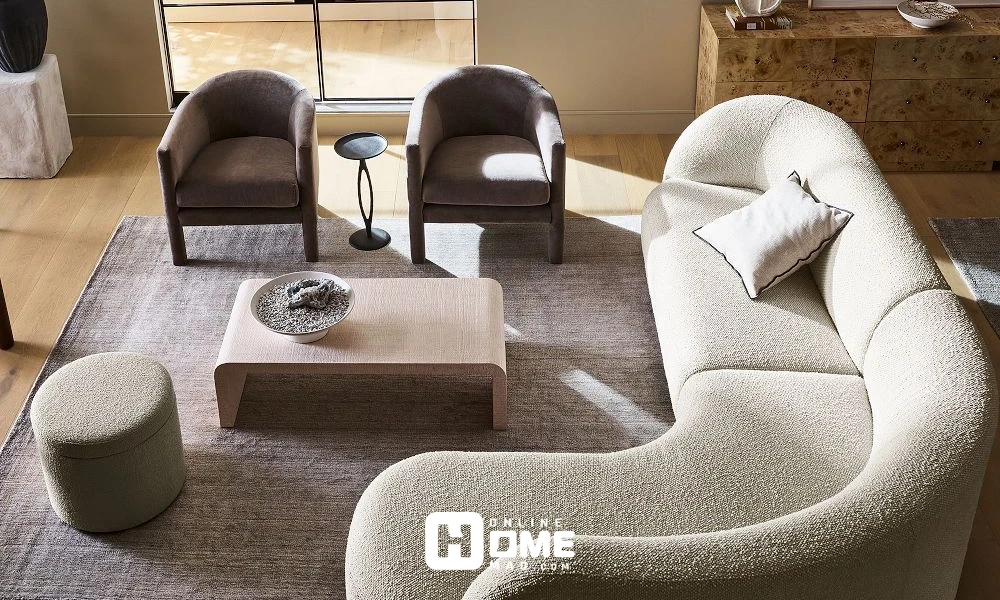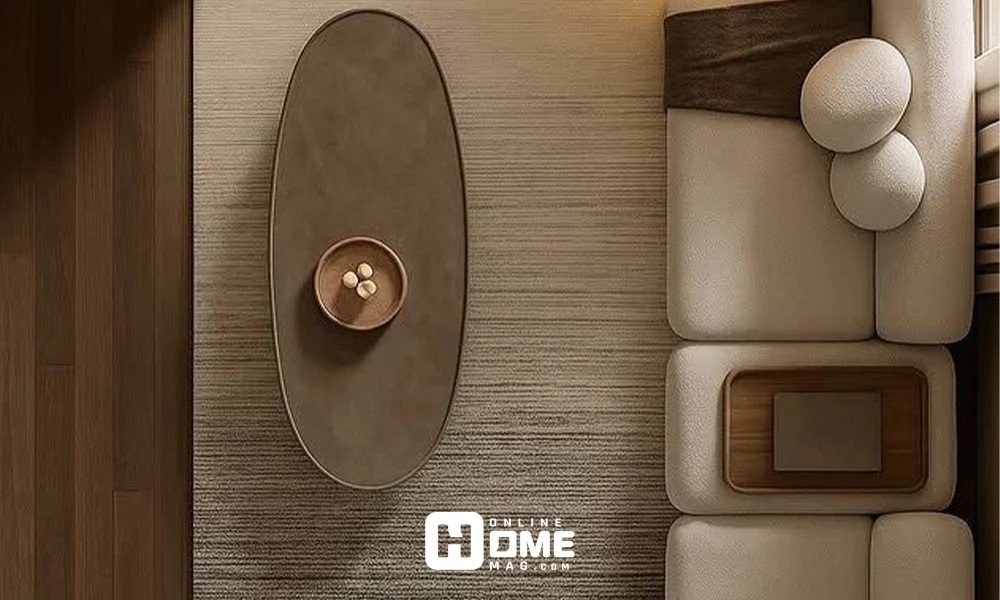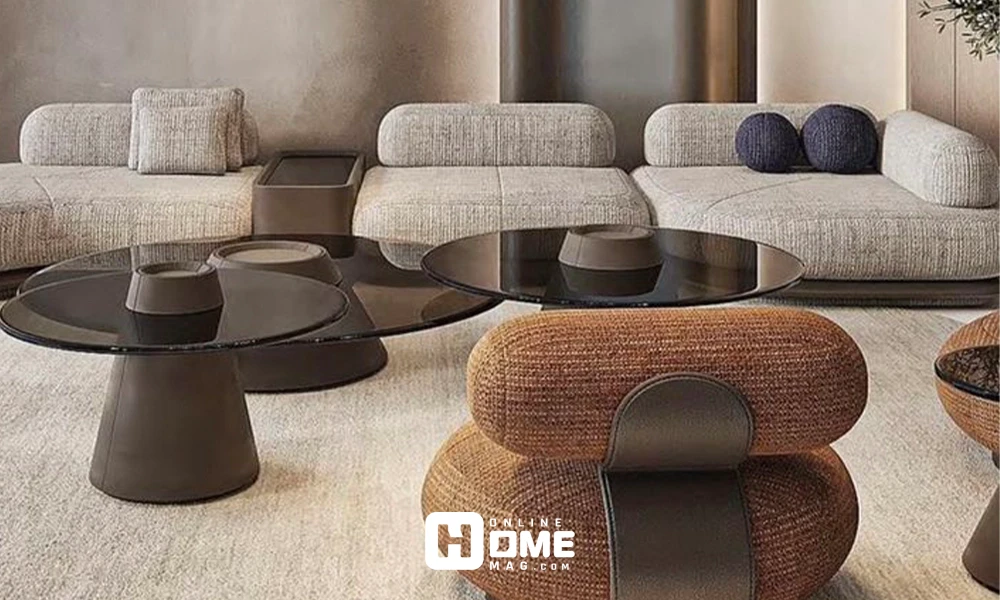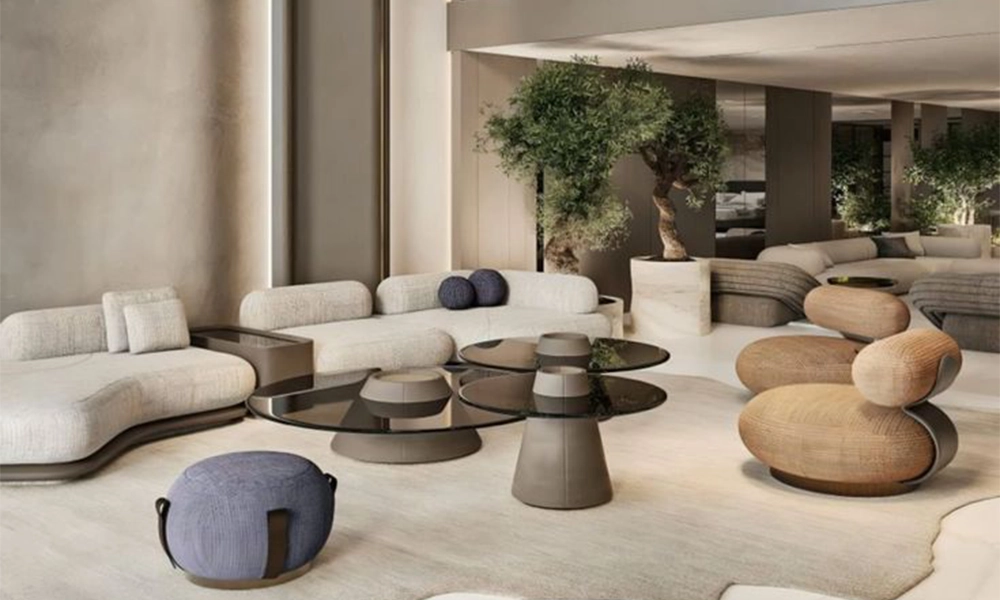🕓 Last updated: October 8, 2025
Why Your Living Room Furniture Matters for Comfort and Design
When searching for living room furniture ideas, it’s essential to stay updated with the latest design trends. The right furniture style can completely transform your space — setting the mood, improving comfort, and reflecting your personal taste. Whether you live in a spacious home or a compact apartment, choosing the right furniture for small space living room can make a huge difference in both functionality and design. Below are the most popular living room furniture styles of 2025 and how to use them beautifully in your home.
Modern & Minimalist Living Room Furniture
The modern minimalist trend is all about simplicity and clean design. It embraces open layouts, functional pieces, and neutral tones like white, beige, and soft gray. Furniture often features sleek metal legs, glass tabletops, and smooth finishes.
Pro tip: Use furniture with hidden storage, like lift-top coffee tables or built-in shelves, to keep your living room tidy.
Best for: Apartments, studios, and anyone who values calm, clutter-free spaces.

Scandinavian Living Room Furniture
Scandinavian design remains a favorite in living room furniture ideas because of its natural light, cozy textures, and minimal look. It uses light wood tones, neutral colors, and soft fabrics to make any space feel welcoming.
Key elements: light oak furniture, woven rugs, linen sofas, and minimalist lighting.
Pro tip: Combine white walls with touches of greenery or pastel decor to add warmth and freshness.
Best for: Small to medium-sized rooms and those who love cozy minimalism.
Boho & Eclectic Living Room Furniture
The boho (bohemian) or eclectic style is full of character and creativity. It blends global influences, rich textures, and artistic expression. Every piece tells a story — from vintage chairs to patterned cushions.
Key elements: rattan or wicker furniture, layered textiles, floor cushions, and handmade accessories.
Pro tip: Mix modern sofas with colorful rugs or antique tables to create visual depth.
Best for: Artistic souls who love vibrant, expressive, and unconventional spaces.
Industrial Living Room Furniture
The industrial style is inspired by urban lofts and warehouse aesthetics. It’s raw, edgy, and full of personality. Furniture often combines wood and metal with visible welds or bolts for an unfinished yet stylish look.
Key elements: leather couches, metal shelves, reclaimed wood coffee tables, and exposed brick accents.
Pro tip: Add soft textiles like throws or rugs to balance the rough materials.
Best for: Lofts, city apartments, or anyone drawn to bold, masculine design.
Mid-Century Modern Living Room Furniture
Mid-century modern furniture is timeless, blending vintage charm with sleek, functional lines. It’s known for tapered legs, organic curves, and warm wooden finishes.
Key elements: walnut coffee tables, low-profile sofas, geometric decor, and brass details.
Pro tip: Mix mid-century furniture with modern lighting to keep it fresh and contemporary.
Best for: Homeowners who love classic style with a touch of retro sophistication.
Comparison Table: Popular Living Room Furniture Styles
| Style | Key Materials | Color Palette | Best For | Overall Vibe |
| Modern & Minimalist | Metal, glass, neutral fabrics | White, beige, gray | Small spaces, modern homes | Clean and functional |
| Scandinavian | Light wood, linen, cotton | White, cream, soft pastels | Cozy, bright spaces | Airy and natural |
| Boho & Eclectic | Rattan, wicker, textiles | Earth tones, bold colors | Artistic, creative homes | Vibrant and personal |
| Industrial | Metal, reclaimed wood, leather | Brown, black, gray | Lofts, urban areas | Raw and edgy |
| Mid-Century Modern | Walnut wood, velvet, brass | Teal, mustard, warm woods | Retro lovers | Timeless and sophisticated |
Trending Living Room Furniture Styles
lifestyle, and aesthetic. The right furniture layout improves both comfort and functionality, making even a small room feel open and well-designed. Whether your living room is large or compact, smart choices can transform its look and flow.
Measure and Plan Before You Buy : Before shopping, measure your living room carefully. Knowing the dimensions helps you avoid overcrowding the space. Create a simple floor plan and visualize how your main furniture pieces will fit together. It’s important to leave comfortable walking space between the sofa, chairs, and coffee table. This planning step ensures your furniture enhances, not restricts, your living room layout.

Furniture for Small Space Living Room :When working with a limited area, choosing furniture for small space living room designs becomes essential. Go for multi-purpose items that combine function and style. A sofa bed, nesting tables, or an ottoman with hidden storage can help you save space without sacrificing comfort.
Select light-colored furniture to make the room feel larger and brighter. Slim-profile sofas with visible legs add visual space, and round coffee tables improve flow. Wall-mounted TV units or floating shelves can free up valuable floor space. Natural light, mirrors, and minimalist arrangements can also create a more open atmosphere.
Choosing the Right Sofa :The sofa is the centerpiece of every living room. Select one that matches the room’s scale and purpose. In small living rooms, a two-seater or modular sofa can offer comfort without taking up too much space. Larger areas can accommodate sectionals or L-shaped couches for extra seating. The choice of material also matters; fabric sofas provide a cozy feel, while leather adds a luxurious and durable touch.
Balancing Style and Function :Every piece of furniture should offer both practicality and beauty. A coffee table can provide extra storage, and a sideboard can serve as both decoration and utility. Keep pathways open to maintain a natural flow through the room. Avoid oversized furniture that blocks light or movement, and match each item’s size to the proportions of your space.
Color and Material Coordination :To create harmony, limit your color palette to two or three main tones and materials. Light woods, neutral fabrics, and subtle metallic details can make the room look unified and balanced. Darker tones may work in larger spaces, but in smaller rooms, they can make the area feel closed in. Choose textures and finishes that complement each other to achieve a cohesive and elegant style.
Quick Summary: Furniture Planning Tips
| Room Size | Furniture Type | Design Focus | Example Pieces |
| Small Living Room | Compact, multi-functional | Maximize space | Sofa bed, lift-top coffee table, nesting tables |
| Medium Living Room | Standard furniture sets | Comfort and flow | Sectional sofa, wooden coffee table |
| Large Living Room | Statement furniture | Zoning and balance | Oversized sofa, accent chairs, large rugs |
Choosing the Right Furniture for Your Space
When exploring living room furniture ideas, the goal is to find pieces hat fit your space, lifestyle, and aesthetic. The right furniture layout improves both comfort and functionality, making even a small room feel open and well-designed. Whether your living room is large or compact, smart choices can transform its look and flow.
Measure and Plan Before You Buy : Before shopping, measure your living room carefully. Knowing the dimensions helps you avoid overcrowding the space. Create a simple floor plan and visualize how your main furniture pieces will fit together. It’s important to leave comfortable walking space between the sofa, chairs, and coffee table. This planning step ensures your furniture enhances, not restricts, your living room layout.
Furniture for Small Space Living Room :When working with a limited area, choosing furniture for small space living room designs becomes essential. Go for multi-purpose items that combine function and style. A sofa bed, nesting tables, or an ottoman with hidden storage can help you save space without sacrificing comfort.
Select light-colored furniture to make the room feel larger and brighter. Slim-profile sofas with visible legs add visual space, and round coffee tables improve flow. Wall-mounted TV units or floating shelves can free up valuable floor space. Natural light, mirrors, and minimalist arrangements can also create a more open atmosphere.
Choosing the Right Sofa :The sofa is the centerpiece of every living room. Select one that matches the room’s scale and purpose. In small living rooms, a two-seater or modular sofa can offer comfort without taking up too much space. Larger areas can accommodate sectionals or L-shaped couches for extra seating. The choice of material also matters; fabric sofas provide a cozy feel, while leather adds a luxurious and durable touch.
Balancing Style and Function :Every piece of furniture should offer both practicality and beauty. A coffee table can provide extra storage, and a sideboard can serve as both decoration and utility. Keep pathways open to maintain a natural flow through the room. Avoid oversized furniture that blocks light or movement, and match each item’s size to the proportions of your space.
Color and Material Coordination :To create harmony, limit your color palette to two or three main tones and materials. Light woods, neutral fabrics, and subtle metallic details can make the room look unified and balanced. Darker tones may work in larger spaces, but in smaller rooms, they can make the area feel closed in. Choose textures and finishes that complement each other to achieve a cohesive and elegant style.
Furniture Planning Tips
| Room Size | Furniture Type | Design Focus | Example Pieces |
| Small Living Room | Compact, multi-functional | Maximize space | Sofa bed, lift-top coffee table, nesting tables |
| Medium Living Room | Standard furniture sets | Comfort and flow | Sectional sofa, wooden coffee table |
| Large Living Room | Statement furniture | Zoning and balance | Oversized sofa, accent chairs, large rugs |
Choosing the right furniture defines how your living room looks and feels. With thoughtful planning, even a small area can become stylish, functional, and inviting. If you want to add a touch of sophistication, explore Modern Coffee Table Ideas to find the perfect centerpiece that completes your design.
Essential Living Room Furniture Pieces
When planning your living room furniture ideas, it’s helpful to start with the key pieces that define comfort, style, and layout. Each furniture element plays a specific role in shaping how your space looks and functions. By choosing the right combination, you can create a living room that feels balanced, welcoming, and complete.
Sofas and Sectionals :The sofa is the anchor of your living room. It determines the seating layout and sets the tone for the entire space. Choose a design that complements your interior theme and suits the size of your room. Sectional sofas are ideal for large areas where you want more seating, while loveseats or modular designs work better in smaller spaces. Consider neutral tones for versatility, or use bold colors to make a statement.
Coffee Tables :Coffee tables are both practical and decorative. They serve as a gathering point for the room and can also add visual texture. Materials like wood, glass, or marble can define the style you want to achieve. For modern interiors, choose clean-lined designs that match your sofa’s proportions. Storage options and coffee tables for small living rooms are perfect for keeping the space tidy, while round shapes improve traffic flow in tighter areas.
TV Stands and Media Consoles :The media console is often the second focal point after the sofa. Select one that offers enough storage for electronics, books, or décor while blending with the room’s style. Floating TV units work well in small spaces, whereas solid wood consoles suit more traditional designs. Keep wires hidden and accessories minimal for a clean, professional look.
Accent Chairs :Accent chairs bring personality and balance to your seating arrangement. They can introduce a new texture or color that refreshes your design. Place one or two chairs near the sofa or by a window to create a cozy reading nook. Choose lightweight frames if you want flexibility to rearrange the space easily.
Shelves and Cabinets :Storage is a vital part of any living room. Open shelving offers an opportunity to display books, plants, or decorative items, while closed cabinets help you maintain a clutter-free look. Floating shelves are excellent for small rooms because they save floor space and draw the eye upward, giving the illusion of height.
Side Tables and Ottomans :Side tables and ottomans complete your living room setup. A side table beside a sofa or chair adds convenience for lighting or beverages, while an ottoman provides extra seating or a place to rest your feet. If storage is limited, choose ottomans with built-in compartments to keep remotes and magazines organized.
Rugs and Lighting :Though not technically furniture, rugs and lighting play a big role in unifying your furniture pieces. The right rug size defines your seating zone, while layered lighting creates depth and comfort. Use a mix of ceiling lights, floor lamps, and table lamps to balance function and ambiance.
A well-furnished living room doesn’t need to be crowded; it only needs carefully chosen pieces that work together. With thoughtful planning and coordination, your living room can feel cohesive, stylish, and effortlessly functional.
Furniture Material & Color Combinations
Selecting the right materials and color combinations is one of the most important parts of developing stylish living room furniture ideas. The right mix can completely change how your space feels—whether you want a cozy, minimalist atmosphere or a bold, luxurious look. Understanding how different materials and colors work together helps create a balanced and timeless design.
Choosing the Right Materials :Each material adds a unique texture and mood to your living room. Wood creates warmth and a natural feel, metal introduces modern elegance, and glass adds lightness and transparency. Combining two or more of these elements can make your living room appear layered and sophisticated. For example, pairing a wooden coffee table with a metal-framed shelf creates contrast and visual interest.
Upholstery materials also influence the atmosphere of your space. Soft fabrics such as linen, cotton, and velvet make the room feel comfortable and inviting, while leather adds refinement and durability. Regular care is essential for maintaining their beauty, and learning simple steps like How to Clean Sofa at Home can help you preserve your furniture for years.
Coordinating Colors :A well-balanced color palette ties your furniture together. Neutral colors such as beige, gray, and white provide a calm foundation that works with most interior styles. Adding accent colors through cushions, rugs, or artwork brings energy and personality without overwhelming the space.
For a bright, modern look, combine light wood furniture with white walls and soft gray upholstery. If you prefer a dramatic and elegant atmosphere, use darker tones such as walnut, navy, or charcoal paired with brass or gold accents. Consistency is key—repeat similar shades in several pieces to maintain visual flow.
Balancing Contrast and Harmony :Contrast gives depth to a room, but too much can feel chaotic. Mix textures instead of clashing colors. For example, a matte wood surface paired with a glossy glass table achieves balance without competing for attention. In small living rooms, lighter materials and colors prevent the space from feeling heavy, while in larger areas, darker tones can create a sense of intimacy.
Finishing Touches :Details such as handles, legs, and trims might seem minor but can unify your design. Matching metallic finishes across lamps, tables, and mirrors adds sophistication. Soft textiles like throws and pillows help connect colors across the room, making the space feel cohesive and complete.
The right combination of materials and colors ensures your living room remains timeless, functional, and beautiful. By coordinating textures, tones, and finishes, you can create an inviting space that truly reflects your personality and lifestyle.
Layout and Arrangement Tips
The way you arrange your furniture can completely transform how your living room looks and feels. Even the most beautiful pieces lose their impact if placed incorrectly. When developing living room furniture ideas, focus on creating a layout that encourages movement, conversation, and balance.

Understanding the Room Shape :Every living room is different, so start by assessing its shape. A square room benefits from symmetrical furniture placement, while a rectangular room often looks better with long seating arrangements that follow its natural flow. Position your largest furniture piece, usually the sofa, first, and then build the rest of the layout around it. This approach ensures balance and proportion.
Creating a Focal Point :A focal point gives structure to your design and draws the eye toward a specific area. It can be a fireplace, a TV wall, or a large window with natural light. Arrange seating so it faces this focal point, creating a cozy and inviting atmosphere. If your room lacks a natural feature, you can create one with artwork, a statement rug, or an elegant coffee table.
Ensuring Comfortable Traffic Flow :A good living room layout allows people to move easily without bumping into furniture. Leave enough space between seating pieces for effortless circulation. Keep at least 18 inches between the sofa and coffee table and around three feet for main walkways. This spacing makes the room feel open and organized while still maintaining intimacy.
Balancing the Furniture Weight :Furniture should be visually balanced. If one side of the room feels heavier with a large sofa, place a bookcase or pair of chairs on the opposite side to distribute weight. Avoid lining every piece along the walls, as this can make the room feel empty in the center. Pulling furniture slightly inward helps create a more conversational layout.
Using Rugs to Define Areas :Rugs are excellent for defining specific zones within your living room, especially in open-concept homes. The rug should be large enough that at least the front legs of your furniture rest on it. Choose patterns or colors that complement your overall theme while adding warmth and texture to the space.
Lighting and Accessories Placement :Lighting is an important part of furniture arrangement. Combine ambient lighting from the ceiling with floor and table lamps to create layers of light. Position lamps near seating areas for reading or relaxing. Accessories such as plants, vases, and mirrors can fill empty corners and help balance visual weight across the room.
A thoughtful layout makes every element of your living room work together in harmony. When your furniture is arranged with purpose, the entire space feels more comfortable, spacious, and beautifully designed.
conclusion
In conclusion, designing your living room is more than just arranging furniture—it’s about creating a space that reflects comfort, style, and personality. When you choose each piece thoughtfully, considering color, size, and placement, the room becomes both functional and inviting. By blending modern design trends with practical living room furniture ideas, you can transform any space, large or small, into a warm, balanced, and inspiring part of your home.


